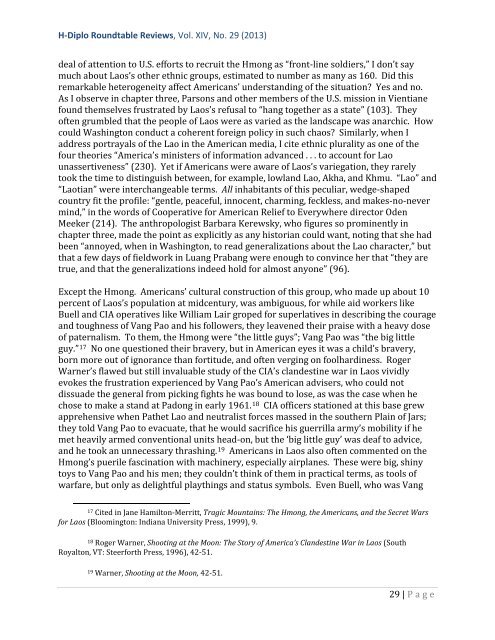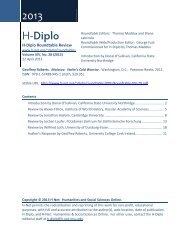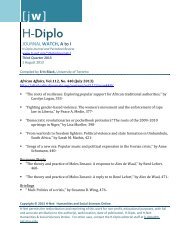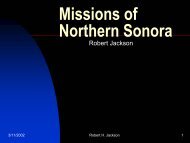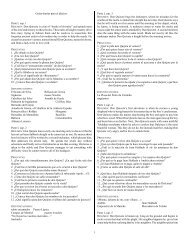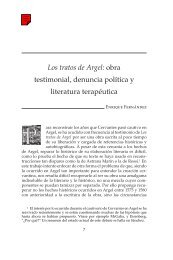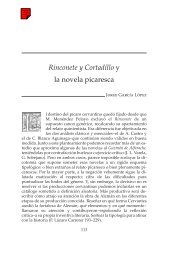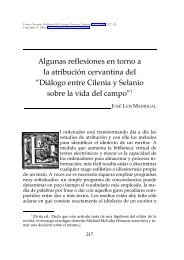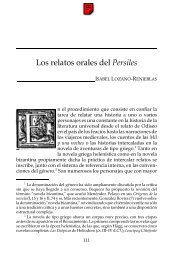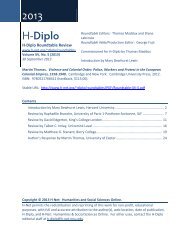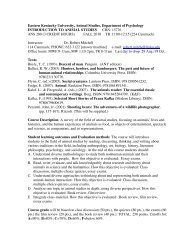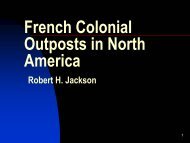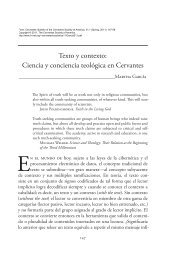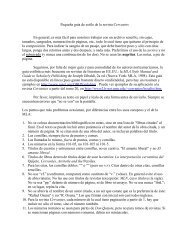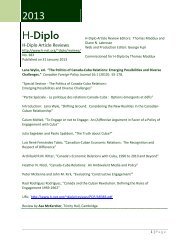H-Diplo Roundtables, Vol. XIV, No. 29 (2013) - H-Net
H-Diplo Roundtables, Vol. XIV, No. 29 (2013) - H-Net
H-Diplo Roundtables, Vol. XIV, No. 29 (2013) - H-Net
Create successful ePaper yourself
Turn your PDF publications into a flip-book with our unique Google optimized e-Paper software.
H-<strong>Diplo</strong> Roundtable Reviews, <strong>Vol</strong>. <strong>XIV</strong>, <strong>No</strong>. <strong>29</strong> (<strong>2013</strong>)<br />
deal of attention to U.S. efforts to recruit the Hmong as “front-line soldiers,” I don’t say<br />
much about Laos’s other ethnic groups, estimated to number as many as 160. Did this<br />
remarkable heterogeneity affect Americans’ understanding of the situation? Yes and no.<br />
As I observe in chapter three, Parsons and other members of the U.S. mission in Vientiane<br />
found themselves frustrated by Laos’s refusal to “hang together as a state” (103). They<br />
often grumbled that the people of Laos were as varied as the landscape was anarchic. How<br />
could Washington conduct a coherent foreign policy in such chaos? Similarly, when I<br />
address portrayals of the Lao in the American media, I cite ethnic plurality as one of the<br />
four theories “America’s ministers of information advanced . . . to account for Lao<br />
unassertiveness” (230). Yet if Americans were aware of Laos’s variegation, they rarely<br />
took the time to distinguish between, for example, lowland Lao, Akha, and Khmu. “Lao” and<br />
“Laotian” were interchangeable terms. All inhabitants of this peculiar, wedge-shaped<br />
country fit the profile: “gentle, peaceful, innocent, charming, feckless, and makes-no-never<br />
mind,” in the words of Cooperative for American Relief to Everywhere director Oden<br />
Meeker (214). The anthropologist Barbara Kerewsky, who figures so prominently in<br />
chapter three, made the point as explicitly as any historian could want, noting that she had<br />
been “annoyed, when in Washington, to read generalizations about the Lao character,” but<br />
that a few days of fieldwork in Luang Prabang were enough to convince her that “they are<br />
true, and that the generalizations indeed hold for almost anyone” (96).<br />
Except the Hmong. Americans’ cultural construction of this group, who made up about 10<br />
percent of Laos’s population at midcentury, was ambiguous, for while aid workers like<br />
Buell and CIA operatives like William Lair groped for superlatives in describing the courage<br />
and toughness of Vang Pao and his followers, they leavened their praise with a heavy dose<br />
of paternalism. To them, the Hmong were “the little guys”; Vang Pao was “the big little<br />
guy.” 17 <strong>No</strong> one questioned their bravery, but in American eyes it was a child’s bravery,<br />
born more out of ignorance than fortitude, and often verging on foolhardiness. Roger<br />
Warner’s flawed but still invaluable study of the CIA’s clandestine war in Laos vividly<br />
evokes the frustration experienced by Vang Pao’s American advisers, who could not<br />
dissuade the general from picking fights he was bound to lose, as was the case when he<br />
chose to make a stand at Padong in early 1961. 18 CIA officers stationed at this base grew<br />
apprehensive when Pathet Lao and neutralist forces massed in the southern Plain of Jars;<br />
they told Vang Pao to evacuate, that he would sacrifice his guerrilla army’s mobility if he<br />
met heavily armed conventional units head-on, but the ‘big little guy’ was deaf to advice,<br />
and he took an unnecessary thrashing. 19 Americans in Laos also often commented on the<br />
Hmong’s puerile fascination with machinery, especially airplanes. These were big, shiny<br />
toys to Vang Pao and his men; they couldn’t think of them in practical terms, as tools of<br />
warfare, but only as delightful playthings and status symbols. Even Buell, who was Vang<br />
17 Cited in Jane Hamilton-Merritt, Tragic Mountains: The Hmong, the Americans, and the Secret Wars<br />
for Laos (Bloomington: Indiana University Press, 1999), 9.<br />
18 Roger Warner, Shooting at the Moon: The Story of America’s Clandestine War in Laos (South<br />
Royalton, VT: Steerforth Press, 1996), 42-51.<br />
19 Warner, Shooting at the Moon, 42-51.<br />
<strong>29</strong> | P age


